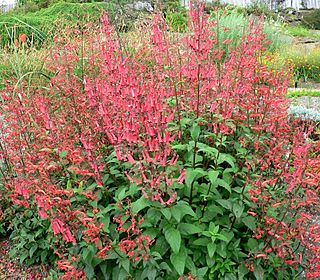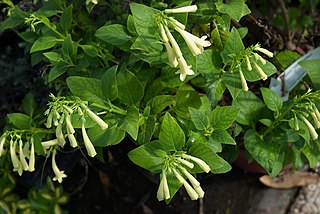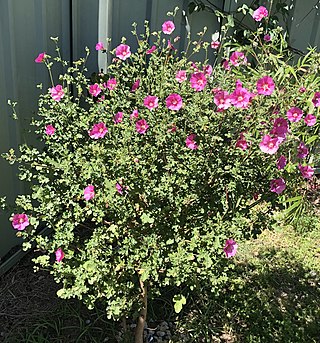
Tropaeolum, commonly known as nasturtium, is a genus of roughly 80 species of annual and perennial herbaceous flowering plants. It was named by Carl Linnaeus in his book Species Plantarum, and is the only genus in the family Tropaeolaceae. The nasturtiums received their common name because they produce an oil similar to that of watercress.

Iris is a flowering plant genus of 310 accepted species with showy flowers. As well as being the scientific name, iris is also widely used as a common name for all Iris species, as well as some belonging to other closely related genera. A common name for some species is flags, while the plants of the subgenus Scorpiris are widely known as junos, particularly in horticulture. It is a popular garden flower.

Dianthus is a genus of about 340 species of flowering plants in the family Caryophyllaceae, native mainly to Europe and Asia, with a few species in north Africa and in southern Africa, and one species in arctic North America. Common names include carnation, pink and sweet william.

Pelargonium is a genus of flowering plants that includes about 280 species of perennials, succulents, and shrubs, commonly called geraniums, pelargoniums, or storksbills. Geranium is also the botanical name and common name of a separate genus of related plants, also known as cranesbills. Both genera belong to the family Geraniaceae. Carl Linnaeus originally included all the species in one genus, Geranium, and they were later separated into two genera by Charles Louis L'Héritier de Brutelle in 1789.

Hypericum is a genus of flowering plants in the family Hypericaceae. The genus has a nearly worldwide distribution, missing only from tropical lowlands, deserts and polar regions. Many Hypericum species are regarded as invasive species and noxious weeds. All members of the genus may be referred to as St. John's wort, and some are known as goatweed. The white or pink flowered marsh St. John's worts of North America and eastern Asia are generally accepted as belonging to the separate genus TriadenumRaf.

Hibiscus rosa-sinensis, known colloquially as Chinese hibiscus, China rose, Hawaiian hibiscus, rose mallow and shoeblack plant, is a species of tropical hibiscus, a flowering plant in the Hibisceae tribe of the family Malvaceae. It is widely cultivated as an ornamental plant in the tropics and subtropics, but its native range is Vanuatu.

Drosera capensis, commonly known as the Cape sundew, is a small rosette-forming carnivorous species of perennial sundew native to the Cape in South Africa. Because of its size, easy to grow nature, and the copious amounts of seed it produces, it has become one of the most common sundews in cultivation, and thus, one of the most frequently introduced and naturalised invasive Drosera species.

Sidalcea is a genus of the botanical family Malvaceae. It contains several species of flowering plants known generally as checkerblooms or checkermallows, or prairie mallows in the United Kingdom. They can be annuals or perennials, some rhizomatous. They are native to West and Central North America.

Phygelius capensis, the cape figwort or cape fuchsia, is a species of flowering plant in the family Scrophulariaceae, native to South Africa and Lesotho.

Acalypha hispida, the chenille plant, is a flowering shrub which belongs to the family Euphorbiaceae, the subfamily Acalyphinae, and the genus Acalypha. Acalypha is the fourth largest genus of the family Euphorbiaceae, and contains many plants native to Hawaii and Oceania.

Tecomaria capensis, the Cape honeysuckle, is a species of flowering plant in the family Bignoniaceae, native to southern Africa. Despite its common name, it is not closely related to the true honeysuckle.

Phygelius, common names Cape fuchsia or Cape figwort, is a genus of flowering plants in the family Scrophulariaceae, native to wet slopes and banks in southern Africa. They are evergreen shrubs often treated as perennials in colder climates. They bear many pendent tubular flowers over a long period in summer, in shades of white, yellow and red. The vague similarity of the blooms to fuchsias has led to the common name Cape fuchsia, though they are not closely related.

Phygelius aequalis is a species of flowering plant in the family Scrophulariaceae, native to South Africa. It is a semi-evergreen shrub growing to 1 m (3 ft) tall and wide, with 25 cm (10 in) long panicles of pink flowers with crimson lobes and yellow throats. This species may be distinguished from the closely related Phygelius capensis by the fact that the flowers grow in a single plane along one side of the stem. The narrowly tubular flowers are up to 6 cm (2 in) in length.

Kumara plicatilis, formerly Aloe plicatilis, the fan-aloe, is a succulent plant endemic to a few mountains in the Fynbos ecoregion, of the Western Cape in South Africa. The plant has an unusual and striking fan-like arrangement of its leaves. It may grow as a large multistemmed shrub or as a small tree. It is one of the two species in the genus Kumara.

Acer palmatum, commonly known as Japanese maple, palmate maple, or smooth Japanese maple (Japanese: irohamomiji, イロハモミジ, or momiji,, is a species of woody plant native to Japan, Korea, China, eastern Mongolia, and southeast Russia. Many different cultivars of this maple have been selected and they are grown worldwide for their large variety of attractive forms, leaf shapes, and spectacular colors.

Veltheimia bracteata is a species of plant. It belongs to the genus Veltheimia, which contains only one other species, Velthemia capensis. Veltheimia bracteata is commonly referred to as the forest lily, sand onion, or red hot poker. This pendent shaped plant ranges in color from a yellowish pink to red. It is a winter flowering perennial plant, so is in full bloom when other flowers have withered away. Plants grow to be 12–18 inches (30–46 cm) in height.

Veltheimia capensis is one of two species of flowering plants belonging to the genus Veltheimia, of the family Asparagaceae. It is a tender bulbous perennial reaching a height of 46 cm (18 in), with flowers varying in color from white with red spots to pink with green or red markings.

Anisodontea capensis, known as African mallow, dwarf hibiscus, Cape mallow and false mallow, is a species in the tribe Malveae in the family Malvaceae that is native to the Cape Provinces of South Africa. It has gained the Royal Horticultural Society's Award of Garden Merit as an ornamental.

Elegia capensis, called the horsetail restio, is a species of grass‑like flowering plant in the genus Elegia, native to the Cape Provinces of South Africa. It has gained the Royal Horticultural Society's Award of Garden Merit.

Anchusa capensis, is a species of flowering plant in the family Boraginaceae, native to Namibia, South Africa and Lesotho. The genus Anchusa is from the Greek word anchousa, which makes reference to its use as a dye base for cosmetic paint obtained from the roots of another plant in the genus Anchusa tinctoria. The species capensis translates to ‘from the Cape’ referring to South Africa




















